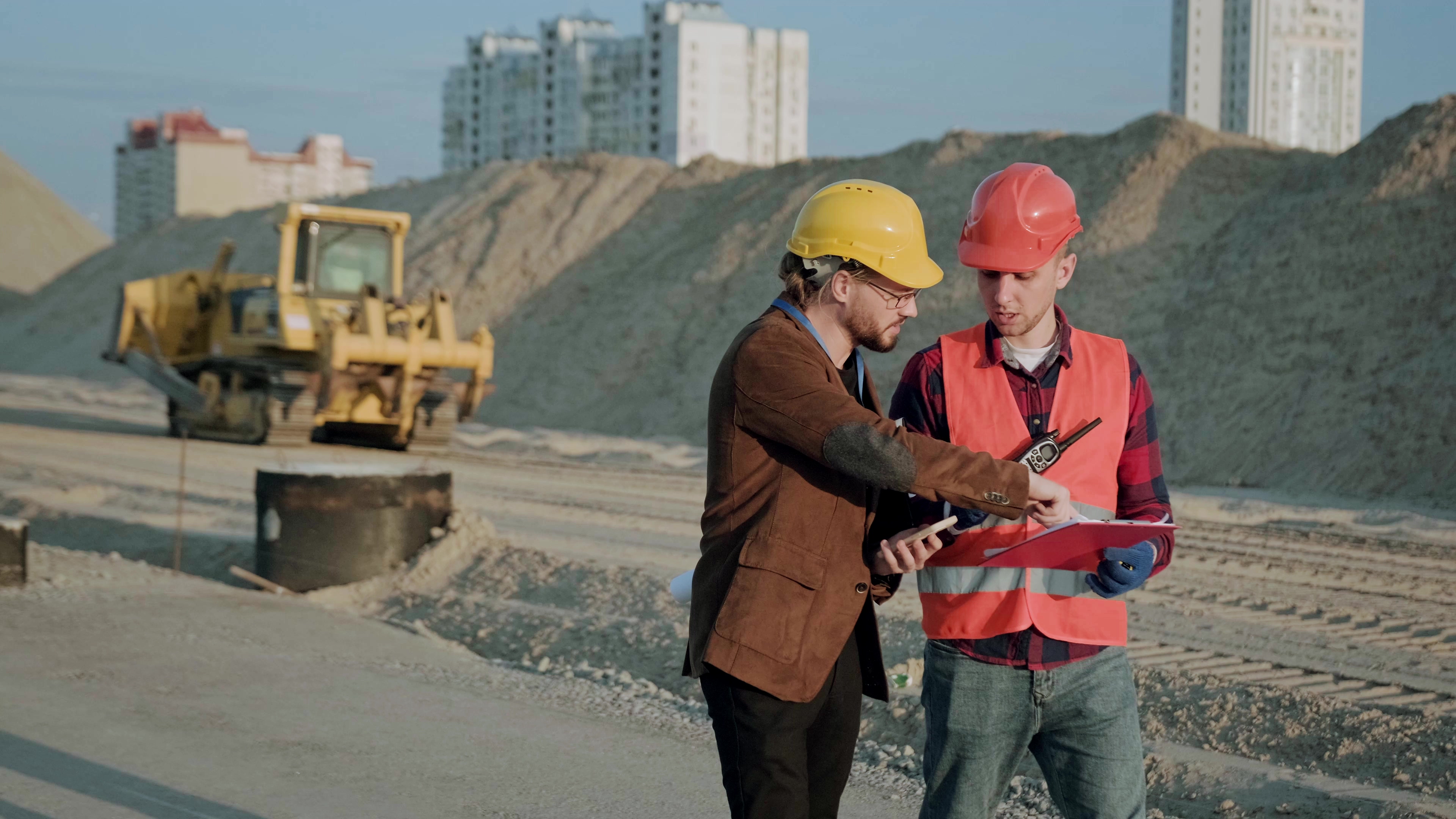Your destination for all things heavy civil – from job site interviews to industry insights.

Heavy civil construction sites are some of the most challenging and dangerous work environments in the construction industry. They involve large machinery, deep digging, intricate infrastructure projects, and many teams working at the same time on vast job sites. When it comes to heavy civil construction safety, there's a lot at stake.
The risks involved in these operations are significant and diverse:
To safeguard your workers and ensure project success, you need thorough site safety rules and strict compliance with construction regulations. This article outlines ten essential safety and compliance rules that every heavy civil construction site must implement. These tried-and-true methods will assist you in establishing a safer workplace while fulfilling all regulatory obligations.
The Occupational Safety and Health Administration (OSHA) is the main federal agency responsible for creating and enforcing workplace safety rules on all construction sites in the United States. OSHA standards are the foundation of construction site safety procedures. They require employers to keep work environments free from hazards and to implement thorough safety programs.
What are OSHA construction site requirements for heavy civil construction projects? The main requirements include:
In addition to following OSHA rules, heavy construction projects must also comply with state regulations. For instance, California's Cal/OSHA has stricter requirements than federal standards, such as more robust protocols for preventing heat-related illnesses and stricter measures for protecting against falls. These construction site regulations create multiple layers of protection that address the specific challenges faced in heavy civil work environments.
It's important to understand that failing to comply with these rules can result in significant financial penalties and even criminal charges. Therefore, following these standards is not only a legal requirement but also essential for running a successful business.
PPE in construction is your first line of defense against workplace hazards on heavy civil sites. It's important to know that protective gear requirements go beyond just hard hats and safety vests.
Essential construction safety clothing and equipment includes:
The importance of PPE in preventing injuries cannot be emphasized enough. Construction sites have injury rates much higher than other industries, with many incidents that could have been avoided by using the right protective gear.
Your employer is responsible for providing suitable PPE at no cost to you. They must ensure that the equipment meets OSHA standards, provide training on how to use and maintain it correctly, and enforce consistent usage across all activities on site. Policies requiring the use of PPE at all times must be strictly enforced, with disciplinary actions for non-compliance in order to uphold safety standards on site.
Building site safety regulations are crucial for ensuring compliance in heavy civil construction projects. It's important to understand that these regulations are not optional—they are legally binding requirements designed to protect lives and prevent costly delays.
Fall protection becomes critical when workers operate at heights exceeding six feet. You need to implement:
Confined space entry requires strict adherence to permit-required protocols. You must establish atmospheric testing procedures, ventilation systems, and emergency rescue plans before any worker enters tanks, manholes, or excavations deeper than four feet.
Electrical safety protocols demand ground-fault circuit interrupters on all temporary power systems. You're responsible for maintaining proper clearances from overhead power lines—typically 10 feet for voltages up to 50kV.
Hazardous materials handling requires proper storage, labeling, and disposal according to Safety Data Sheets. You must train workers on chemical exposure risks and provide appropriate respiratory protection when handling materials like silica-containing products or asbestos-containing materials during demolition activities.
Site induction training is essential for setting safety expectations before any worker arrives at your heavy civil construction site. Every person entering the worksite, whether they're experienced operators or new subcontractors, must go through thorough worker orientation construction programs that cover site-specific hazards and protocols.
Your induction program should include the following key components:
Effective safety communication involves more than just reading safety manuals. It's important to ensure understanding through interactive discussions, visual demonstrations, and practical examples that are relevant to the specific project. Whenever possible, conduct inductions in workers' primary languages and use visual aids to overcome any language barriers.
Documentation is crucial—keep records of all completed inductions, including dates, attendees, and topics covered. This not only holds individuals accountable but also shows your commitment to meeting regulatory requirements during inspections.
Construction site safeguards are essential for protecting workers and preventing accidents on heavy civil projects. It's important to have multiple layers of barriers and controls in place to keep unauthorized individuals out of dangerous areas and safeguard workers from equipment-related risks.
Perimeter fencing acts as the first line of defense against unauthorized entry. Install strong barriers around excavation sites, crane operation zones, and areas where heavy machinery is actively being used. The hazard barriers construction sites require should include:
Lockout/tagout procedures are crucial for preventing accidental startup of equipment during maintenance activities. It's important to establish energy isolation protocols for all heavy machinery on site, including excavators, cranes, and conveyor systems. Each specific piece of equipment will require its own lockout devices, and only authorized personnel will have the ability to remove tags once maintenance has been completed.
Visual warning systems are an effective way to communicate immediate dangers to workers. Make sure to place reflective signage at eye level, use color-coded labels for different types of hazards, and ensure that all warnings remain visible regardless of weather conditions. Additionally, it is important that your hazard labels comply with OSHA's Hazard Communication Standard by including pictograms, signal words, and precautionary statements.
Job site cleanliness is a crucial aspect of construction safety that directly affects worker protection and operational efficiency. Keeping work areas clean and organized helps reduce the risk of trips and falls by removing scattered tools, loose materials, and construction debris that can lead to serious injuries. In case of medical emergencies or evacuations, it's essential for emergency responders to have clear access routes, which is why managing debris on construction sites is such an important safety consideration.
Heavy civil construction sites must adhere to specific cleanliness standards set by safety and compliance regulations. To meet these requirements, you need to establish daily cleanup protocols that include:
Properly organizing the storage of materials prevents accidents caused by unstable stacks or improperly secured items. You should implement color-coded storage zones and maintain clear labeling systems for quick identification. Regular inspections will help ensure compliance with the benefits of maintaining a clean job site, which go beyond safety to include improved productivity, better tracking of materials, and a more professional appearance that showcases your commitment to quality construction practices.
Traffic control for construction sites becomes critical when heavy equipment operates alongside workers and delivery vehicles. You need comprehensive planning to prevent collisions and create safe movement patterns throughout your project area.
Establish clear traffic control construction sites protocols using these essential elements:
Create distinct pathways to eliminate dangerous interactions:
Position spotters when heavy equipment operates near pedestrian areas. Your operators need clear sight lines and communication protocols with ground personnel. Radio systems enable immediate coordination between equipment operators, flaggers, and site supervisors during complex maneuvers.
Equipment inspection on construction sites requires strict protocols to prevent major failures and workplace injuries. Heavy machinery operators must complete certified training programs specific to their equipment type, whether operating cranes, forklifts, or earthmoving machinery. OSHA requires operators to demonstrate competency through written and practical examinations before receiving certification.
Safe operation of heavy machinery begins with thorough inspections before each shift. You need to establish daily inspection checklists covering:
Construction equipment inspections must follow manufacturer-recommended schedules, with detailed documentation maintained for each piece of equipment. Your maintenance records should include inspection dates, identified defects, corrective actions taken, and inspector signatures. This documentation proves compliance during OSHA audits and helps identify recurring mechanical issues.
Proper use of construction equipment requires establishing lockout/tagout procedures during maintenance activities. You must train operators to recognize equipment limitations, load capacities, and environmental conditions that affect safe operation. Equipment showing signs of wear or malfunction must be immediately removed from service until repairs are completed and documented.
A construction emergency action plan serves as your site's lifeline when unexpected situations arise. Heavy civil construction sites face unique risks that demand specialized incident response planning heavy civil work protocols.
Your emergency action plan construction sites must include these critical elements:
Site safety and compliance rules to follow for heavy civil construction sites require preparation for both medical emergencies and environmental hazards. Stock first aid stations with supplies appropriate for construction injuries. Train designated personnel in CPR and basic emergency response. Address potential environmental emergencies like chemical spills or equipment fires.
Assign specific emergency responsibilities to trained personnel. Designate evacuation wardens for each work zone, emergency coordinators to interface with first responders, and personnel responsible for accounting for all workers during evacuations. Regular drills ensure everyone understands their role when seconds count.
Ongoing safety training construction workers receive must evolve alongside project phases and emerging hazards. Heavy civil construction sites present unique challenges as excavation depths change, equipment rotates, and weather conditions shift. You need specialized training modules that address site-specific risks like trench collapse, crane operations near power lines, and silica exposure during concrete cutting.
Effective training programs incorporate hands-on demonstrations, equipment-specific certifications, and regular refresher sessions. New workers require comprehensive orientation, while experienced personnel benefit from targeted updates on regulatory changes and emerging safety technologies.
Incident investigation procedures form the backbone of continuous improvement. When accidents or near-misses occur, you must implement systematic investigation protocols:
Investigation findings should drive training modifications, equipment upgrades, and procedural changes. You create a learning culture where workers feel comfortable reporting near-misses without fear of punishment, enabling proactive hazard identification and prevention strategies.
Heavy civil construction safety requires project managers to be fully committed during every stage of construction. These site safety and compliance rules are crucial for successful project completion and the protection of your most valuable asset—your workforce.
Safety cannot be an afterthought or just something you check off a list. Each rule we've discussed needs to be actively put into practice, regularly monitored, and continuously improved. Your responsibility goes beyond simply reviewing compliance best practices; you must promote a culture where safety becomes instinctive for every team member.
The future of the construction industry relies on leaders who understand that strong safety measures directly impact project efficiency, worker retention, and company reputation. By prioritizing these essential safety elements, you create an environment where workers feel valued, protected, and empowered to do their best work while returning home safely at the end of each day.
.png)
.svg)

.svg)
.jpg)
.svg)